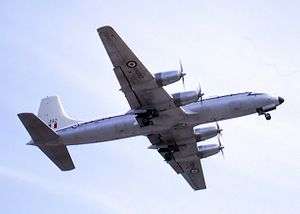Canadian Pacific Air Lines Flight 301
Canadian Pacific Air Lines Flight 301 was a scheduled passenger flight from Honolulu, Hawaii to Nadi, Fiji. On 22 July 1962, it was being operated by a Bristol Britannia 314 four-engine turboprop airliner of Canadian Pacific Air Lines, registered CF-CZB.[1] On departure from Honolulu International Airport, the aircraft had engine problems; while attempting a subsequent return and landing on three engines, the crew initiated a go-around that resulted in the plane crashing on the airfield, killing 27 of the 40 on board.[1]
 A Bristol Brittania similar to the accident aircraft | |
| Accident | |
|---|---|
| Date | 22 July 1962 |
| Summary | Crashed after a failed go-around on approach |
| Site | Honolulu International Airport, Honolulu, Hawaii, United States |
| Aircraft | |
| Aircraft type | Bristol Britannia 314 |
| Aircraft name | Empress of Lima |
| Operator | Canadian Pacific Air Lines |
| Registration | CF-CZB |
| Flight origin | Honolulu International Airport, Honolulu, Hawaii, United States |
| Destination | Nadi International Airport, Fiji |
| Occupants | 40 |
| Passengers | 29 |
| Crew | 11 |
| Fatalities | 27 |
| Injuries | 13 |
| Survivors | 13 |
Accident
Shortly after take-off from Honolulu, the crew received an engine fire warning for the number one engine, which they feathered. They then jettisoned fuel before returning to Honolulu 40 minutes later.[1] Their three-engined approach appeared to be normal, but at the last minute the crew decided to go around and attempt another approach.[1]
The aircraft then banked and veered to the left, and the left wing tip hit the ground about 550' from the center of the runway.[1] The aircraft disintegrated as it moved across the airfield before hitting some heavy earth-moving equipment.[1] Apart from the rear fuselage and tail, the aircraft was destroyed by fire. Thirteen on board escaped, but 7 crew and 20 passengers were killed.[1]
Aircraft
The aircraft, a Bristol Britannia 314 four-engined turboprop, was built in the United Kingdom, and first flew on 14 April 1958.[2] It was delivered new to Canadian Pacific Air Lines on 29 April 1958, and was originally named Empress of Vancouver (later renamed Empress of Lima).[2]
Probable cause
The accident investigation board concluded the probable cause of the accident was "the attempted three-engine go-around, when the aircraft was in a full landing configuration, at insufficient airspeed and altitude to maintain control."[1]
References
- Citations
- Civil Aviation Authority 1974, p. 18/62
- Eastwood 1991, p. 73
- Bibliography
- World Accident Summary. Civil Aviation Authority (United Kingdom). 1974. ISBN 0-903083-44-2.
- Eastwood, Tony; John Roach (1991). Turbo Prop Airliner Production List. The Aviation Hobby Shop. ISBN 0-907178-32-4.